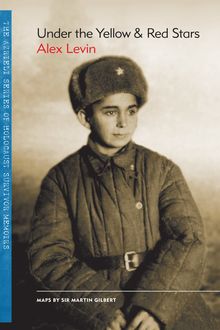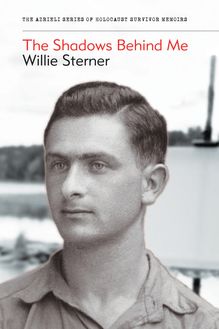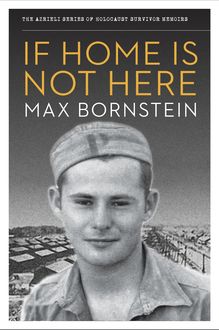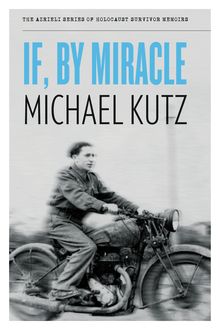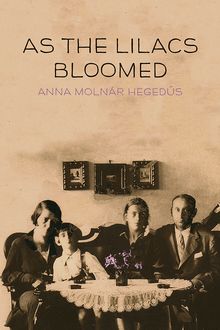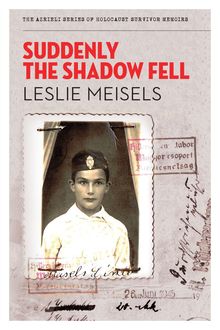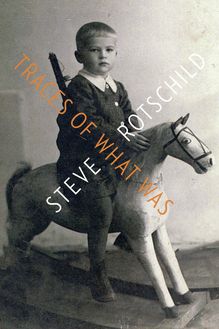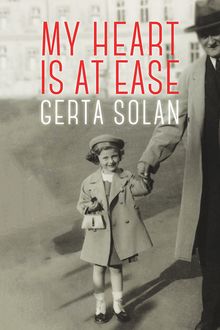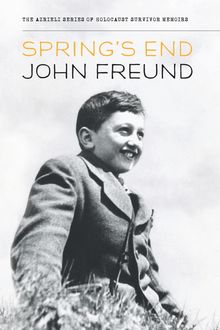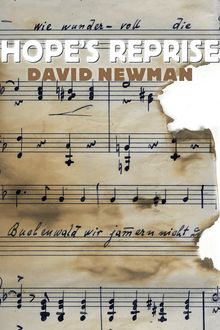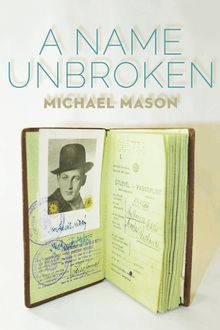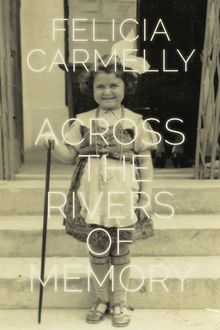-
 Univers
Univers
-
 Ebooks
Ebooks
-
 Livres audio
Livres audio
-
 Presse
Presse
-
 Podcasts
Podcasts
-
 BD
BD
-
 Documents
Documents
-
- Cours
- Révisions
- Ressources pédagogiques
- Sciences de l’éducation
- Manuels scolaires
- Langues
- Travaux de classe
- Annales de BEP
- Etudes supérieures
- Maternelle et primaire
- Fiches de lecture
- Orientation scolaire
- Méthodologie
- Corrigés de devoir
- Annales d’examens et concours
- Annales du bac
- Annales du brevet
- Rapports de stage
La lecture à portée de main
Vous pourrez modifier la taille du texte de cet ouvrage
Découvre YouScribe en t'inscrivant gratuitement
Je m'inscrisDécouvre YouScribe en t'inscrivant gratuitement
Je m'inscrisEn savoir plus
Vous pourrez modifier la taille du texte de cet ouvrage
En savoir plus

Description
Sujets
Informations
| Publié par | Azrieli Foundation |
| Date de parution | 01 septembre 2014 |
| Nombre de lectures | 1 |
| EAN13 | 9781897470855 |
| Langue | English |
| Poids de l'ouvrage | 2 Mo |
Informations légales : prix de location à la page 0,0300€. Cette information est donnée uniquement à titre indicatif conformément à la législation en vigueur.
Extrait
Traces of What Was
Steve Rotschild-Galerkin
The Azrieli Series of Holocaust Survivor Memoirs
Naomi Azrieli, Publisher
Jody Spiegel, Program Director
Arielle Berger, Managing Editor
Elizabeth Lasserre, Senior Editor, French-Language Editions
Aurélien Bonin, French-Language Educational Outreach and Events
Catherine Person, Quebec Educational Outreach and Events
Elin Beaumont, English-language Educational Outreach and Events
Tim MacKay, New Media and Marketing
Susan Roitman, Executive Assistant and Office Manager (Toronto)
Mary Mellas, Executive Assistant and Human Resources (Montreal)
Eric Bélisle, Administrative Assistant
Mark Goldstein, Art Director
François Blanc, Cartographer
Bruno Paradis, Layout, French-language editions
Contents
The Azrieli Series of Holocaust Survivor Memoirs
Series Preface: In their own words...
About the Glossary
Introduction
Epigraph
Dedication
Popishok
The Fiodorovs
The Ghetto
Escape from the Ghetto
HKP
Children’s Aktion and the Liquidation
End of a Nightmare
The House on Subocz Street
The Accident
New Beginnings
Epilogue
Glossary
Photographs
Copyright
About the Azrieli Foundation
Also Available
Series Preface: In their own words...
In telling these stories, the writers have liberated themselves. For so many years we did not speak about it, even when we became free people living in a free society. Now, when at last we are writing about what happened to us in this dark period of history, knowing that our stories will be read and live on, it is possible for us to feel truly free. These unique historical documents put a face on what was lost, and allow readers to grasp the enormity of what happened to six million Jews – one story at a time.
David J. Azrieli , C.M., C.Q., M.Arch
Holocaust survivor and founder, The Azrieli Foundation
Since the end of World War II , over 30,000 Jewish Holocaust survivors have immigrated to Canada. Who they are, where they came from, what they experienced and how they built new lives for themselves and their families are important parts of our Canadian heritage. The Azrieli Foundation’s Holocaust Survivor Memoirs Program was established to preserve and share the memoirs written by those who survived the twentieth-century Nazi genocide of the Jews of Europe and later made their way to Canada. The program is guided by the conviction that each survivor of the Holocaust has a remarkable story to tell, and that such stories play an important role in education about tolerance and diversity.
Millions of individual stories are lost to us forever. By preserving the stories written by survivors and making them widely available to a broad audience, the Azrieli Foundation’s Holocaust Survivor Memoirs Program seeks to sustain the memory of all those who perished at the hands of hatred, abetted by indifference and apathy. The personal accounts of those who survived against all odds are as different as the people who wrote them, but all demonstrate the courage, strength, wit and luck that it took to prevail and survive in such terrible adversity. The memoirs are also moving tributes to people – strangers and friends – who risked their lives to help others, and who, through acts of kindness and decency in the darkest of moments, frequently helped the persecuted maintain faith in humanity and courage to endure. These accounts offer inspiration to all, as does the survivors’ desire to share their experiences so that new generations can learn from them.
The Holocaust Survivor Memoirs Program collects, archives and publishes these distinctive records and the print editions are available free of charge to libraries, educational institutions and Holocaust-education programs across Canada. They are also available for sale to the general public at bookstores. All revenues to the Azrieli Foundation from the sales of the Azrieli Series of Holocaust Survivor Memoirs go toward the publishing and educational work of the memoirs program.
The Azrieli Foundation would like to express appreciation to the following people for their invaluable efforts in producing this book: Sherry Dodson (Maracle Press), Sir Martin Gilbert, Farla Klaiman, Andrea Knight, Malcolm Lester, Therese Parent, David Suissa, and Margie Wolfe and Emma Rodgers of Second Story Press.
About the Glossary
The following memoir contains a number of terms, concepts and historical references that may be unfamiliar to the reader. For information on major organizations; significant historical events and people; geographical locations; religious and cultural terms; and foreign-language words and expressions that will help give context and background to the events described in the text, please see the Glossary .
Introduction
How we approach, read and appreciate Holocaust survivor memoirs is not how we approach, read and appreciate most books, and rightly so. We may read a Holocaust memoir and be struck by its aesthetics, style and dramatic story, but we also value the simple fact that it exists, is real and true and accessible, that its contents are known and knowable. Holocaust memoirs are in many ways memorials in book form, offering a way to access, cherish and safeguard memories that are critical to access, cherish and safeguard. Collectively, survivor memoirs represent the ongoing attempt to build, restore and maintain not what was lost – for that is a tragically impossible goal – but the memory of what was lost. In this sense, the reader is not only a reader, but also a receiver . The scholar David Patterson has written that the reader of a Holocaust memoir “must become not an interpreter of texts but a mender of the world, a part of the recovery that this memory demands.” 1
From a literary perspective, the Holocaust memoir is kadosh , holy – it has something of the sacred, of the sui generis , of the incommensurable. To discuss a Holocaust memoir purely in terms of style is to miss the point entirely. And yet, memoirs are not necessarily only about being true and accessible; the great and lasting memoirs are, without exception, literary works of the highest calibre. Primo Levi, Elie Wiesel and Anne Frank did not merely tell their extraordinary stories, they told their stories extraordinarily well. Their writing style – their formal innovation, exacting prose – are qualities integral to the experience of reading and absorbing their stories, of having the kind of experience the author intended.
In this manner, Steve Rotschild’s memoir is a rare and special book, a memoir – the story of a Jewish boy in a war zone, in a ghetto, in hiding – written with the utmost skill, care and love. A professor of mine once described literature as that which cannot be summarized; literature is what’s beyond or beneath the hard facts – it is the difference between knowing an author’s story and feeling a person’s experience. It’s why stories aren’t told in bullet points.
That said, even in bullet points Mr. Rotschild’s story is gripping and terrifying: hiding in the Vilna ghetto; living under a false identity with a Russian family; his father’s death; escaping the ghetto with his mother; hiding, again, at HKP , a forced labour camp; hiding, again, behind a fake wall while German soldiers searched for the children. But this memoir is so much more than an assemblage of harrowing events. It is patient, subtle, deeply felt, finely wrought and considered. It is, at times, wonderfully strange. There are moments of delight, moments of wonder; it is continually vibrant and alive.
Although Traces of What Was contains terror and tragedy, it would be a mistake to say it is about the terror and tragedy. Rotschild’s uncle’s wedding –which took place in 1938, before the war, before the Germans occupied Vilna – is recounted with as much care and attention as his experience in the ghetto. His stay at his grandparents’ house, where he learned to play with the country children, is as formative and significant as his pretending to be the Christian nephew of a Russian family. The overall effect is unaffected, genuine. Rotschild is not only offering his experience as a witness to history, as the testimony of a survivor often does, he is, in the manner of the artist, offering himself. It is a special book wherein every sentence feels both necessary and surprising.
As a reader, I’m amazed by Mr. Rotschild’s recall of people, events and places, how he commands memories of colours, sounds, faces, clothes. As a writer, I’m humbled by how effectively he deploys these details, how deftly he creates momentum, urgency, setting, realness and familiarity. There are countless examples. His “grandparents’ house was built of square logs that turned a dark mahogany colour with age.” In a remarkable passage, Rotschild describes his fear of the nights in the ghetto – not the dark but the sounds: the “chorus of snoring in the stillness of the night… the distinctive… ping of a strong stream of urine hitting the metal of the copper pot, and the sound one older man made by grinding his teeth.” These are sentences one wants to hear read aloud. Rotschild returns, again and again, to sounds: screams in the ghetto hospital; steel-shod boots on the other side of a false wall.
Throughout, Steve Rotschild is bravely, astonishingly unsentimental. The details, no matter how horrifying, are rec
-
 Univers
Univers
-
 Ebooks
Ebooks
-
 Livres audio
Livres audio
-
 Presse
Presse
-
 Podcasts
Podcasts
-
 BD
BD
-
 Documents
Documents
-
Jeunesse
-
Littérature
-
Ressources professionnelles
-
Santé et bien-être
-
Savoirs
-
Education
-
Loisirs et hobbies
-
Art, musique et cinéma
-
Actualité et débat de société
-
Jeunesse
-
Littérature
-
Ressources professionnelles
-
Santé et bien-être
-
Savoirs
-
Education
-
Loisirs et hobbies
-
Art, musique et cinéma
-
Actualité et débat de société
-
Actualités
-
Lifestyle
-
Presse jeunesse
-
Presse professionnelle
-
Pratique
-
Presse sportive
-
Presse internationale
-
Culture & Médias
-
Action et Aventures
-
Science-fiction et Fantasy
-
Société
-
Jeunesse
-
Littérature
-
Ressources professionnelles
-
Santé et bien-être
-
Savoirs
-
Education
-
Loisirs et hobbies
-
Art, musique et cinéma
-
Actualité et débat de société
- Cours
- Révisions
- Ressources pédagogiques
- Sciences de l’éducation
- Manuels scolaires
- Langues
- Travaux de classe
- Annales de BEP
- Etudes supérieures
- Maternelle et primaire
- Fiches de lecture
- Orientation scolaire
- Méthodologie
- Corrigés de devoir
- Annales d’examens et concours
- Annales du bac
- Annales du brevet
- Rapports de stage
